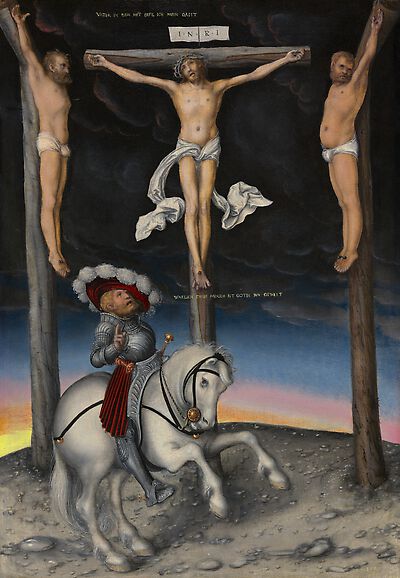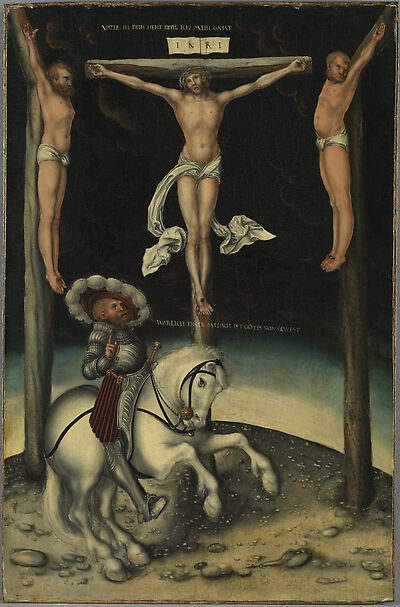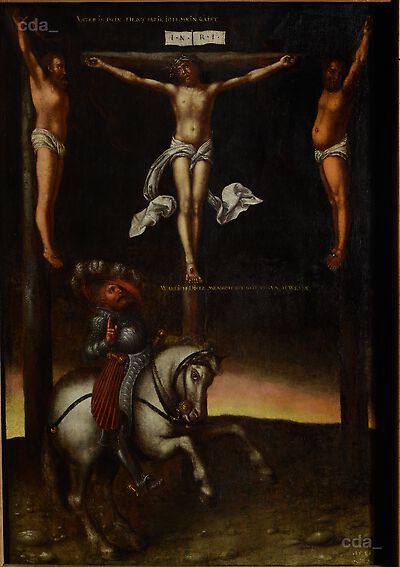- Attributions
-
Lucas Cranach the Elder
Lucas Cranach the Younger
Attributions
| Lucas Cranach the Elder | |
| Lucas Cranach the Younger | [Flechsig 1900, 275] |
| Hans Cranach | [Flechsig 1900, 275] |
- Production date
- 1536
Production date
| 1536 | [dated] |
- Dimensions
- Dimensions of support: 50.8 x 34.6 cm (20 x 13 5/8 in.)
Dimensions
Dimensions of support: 50.8 x 34.6 cm (20 x 13 5/8 in.)
Dimensions including frame: 67.6 x 51.7 x 5.3 cm (26 5/8 x 20 3/8 x 2 1/16 in.)
- Signature / Dating
Artist's insignia at the bottom right: winged serpent with dropped wings and dated '1536'
Signature / Dating
Artist's insignia at the bottom right: winged serpent with dropped wings and dated '1536'
- Inscriptions and Labels
-
across top:
'VATER IN DEIN HE[N]T BEFIL ICH MEIN GAIST'
(Father, into thy hand I commend my spirit) -
at …
Inscriptions and Labels
Inscriptions, Badges:
- across top:
'VATER IN DEIN HE[N]T BEFIL ICH MEIN GAIST'
(Father, into thy hand I commend my spirit)
- at top of cross:
'I.N.R.I'
- centre, below Christ's feet:
'WARLICH DISER MENSCH IST GOTES SVN GEWEST'
(Truly, this man was the Son of God)
- Owner
- National Gallery of Art, Washington, D. C.
- Repository
- National Gallery of Art, Washington, D. C.
- Location
- Washington
- CDA ID
- US_NGA_1961-9-69
- FR (1978) Nr.
- FR378C
- Persistent Link
- https://lucascranach.org/en/US_NGA_1961-9-69/
-
Provenance
- Dr. Demiani, Leipzig, by 1899 [1]
- (sale, Rudolph Lepke, Berlin, 11 November 1913, no. 40)
- Mrs. Jenö Hubay, née Countess Cebrian Rosa
- sold after her husband's death in 1937 to Mathias Salamon
- acquired 1947 by Aladar Feigel, Budapest; George Biro [2]
- sold 1952 to (Dominion Gallery, Montreal)
- sold 1952 to (M. Knoedler & Co., New York), jointly owned by (Pinakos, Inc) [3]
- purchased February 1952 by the Samuel H. Kress Foundation, New York
- gift 1961 to NGA [4]
[1] Lent to the 1899 Cranach-Ausstellung in Dresden.
[2] Letter dated 8 January 1952 from George Biro to the Dominion Gallery, Dominion Gallery Fonds, Nox 71, file 4, purchased 1951-1959, A-E, National Gallery of Canada (copy NGA curatorial files). Also letter of 8 January 1952 from Max Stern, Dominion Gallery, to Charles Henschel, M. Knoedler & Co., in Knoedler files (copy NGA curatorial records).
[3] Letter of 2 March 1988 from Nancy C. Little to John Hand, in NGA curatorial files. A report of the Getty Provenance Index, in curatorial files, states that the painting was jointly owned by Pinakos, Inc. (Rudolf Heinemann).
[4] Painting at NGA from June 1953 but was not formally accessioned by the Gallery until 1961.
[NGA online database, accessed 23.11.2021]
Exhibitions
Dresden 1899, no. 65
Pennsylvania 2007
Literature
| Reference on page | Catalogue Number | Figure / Plate | |||||||||||||||||
| Sitt, Monsees 2015 | 313, 316 | ||||||||||||||||||
|
|||||||||||||||||||
| Exhib. Cat. Allentown 2006 | Fig. 21 | ||||||||||||||||||
|
|||||||||||||||||||
| Hand 2004 | 136-137 | No. 103 | Fig. | ||||||||||||||||
|
|||||||||||||||||||
| Koerner 2004 | 226-239 | Figs. 106, 111 | |||||||||||||||||
|
|||||||||||||||||||
| Löcher 1995 A | 15 | ||||||||||||||||||
|
|||||||||||||||||||
| Grimm 1994 | 37 | Fig. A23 | |||||||||||||||||
|
|||||||||||||||||||
| Cat. Washington 1993 | 44-48 | Fig. p. 47 | |||||||||||||||||
|
|||||||||||||||||||
| Hand 1993 | 54-55, 68 | Figs. | |||||||||||||||||
|
|||||||||||||||||||
| Cat. Washington 1985 | 106 | Fig. | |||||||||||||||||
|
|||||||||||||||||||
| Cat. Washington 1984 | 165 | No. 181 | Fig. | ||||||||||||||||
|
|||||||||||||||||||
| Wolff 1983 | unpaginated | Fig. | |||||||||||||||||
|
|||||||||||||||||||
| Abrams, Hutchinson 1982 | 123-124 | Fig. | |||||||||||||||||
|
|||||||||||||||||||
| White 1982 | 5-9 | ||||||||||||||||||
|
|||||||||||||||||||
| Andersson 1981 | |||||||||||||||||||
|
|||||||||||||||||||
| Dixon 1981 | 35-42 | ||||||||||||||||||
|
|||||||||||||||||||
| Friedländer, Rosenberg 1979 | No. 378C | ||||||||||||||||||
|
|||||||||||||||||||
| Eisler 1977 | 24-25 | Fig. 15 | |||||||||||||||||
|
|||||||||||||||||||
| CDA.Cat. Washington 1975 A | 165 | No. 187 | Fig. p. 164 | ||||||||||||||||
|
|||||||||||||||||||
| CDA.Cat. Washington 1975 B | 86 | Fig. p. 87 | |||||||||||||||||
|
|||||||||||||||||||
| Exhib. Cat. Basel 1974/1976 | 575 | ||||||||||||||||||
|
|||||||||||||||||||
| Schade 1974 | 86 | No. 635 | |||||||||||||||||
|
|||||||||||||||||||
| Angulo Iñiguez 1972 | 6 | ||||||||||||||||||
|
|||||||||||||||||||
| Cat. New Haven 1972 | under No. 6 | ||||||||||||||||||
|
|||||||||||||||||||
| CDA.Cat. Washingtion 1968 | 27 | No. 1621 | |||||||||||||||||
|
|||||||||||||||||||
| Talbot 1967 | 68, 71-78, 86, Fn. 15 | Fig. p. 69 | |||||||||||||||||
|
|||||||||||||||||||
| Cat. Washington 1965 | 34 | ||||||||||||||||||
|
|||||||||||||||||||
| Cat. New Haven 1961 | 40, 41 | Fig. 41 | |||||||||||||||||
|
|||||||||||||||||||
| Cat. Washington 1959 | 309 | Fig. | |||||||||||||||||
|
|||||||||||||||||||
| Suida, Shapley 1956 | 60 | No. 20 | Fig. p. 61 | ||||||||||||||||
|
|||||||||||||||||||
| Friedländer, Rosenberg 1932 | 85 | 303 (mentioned under) | |||||||||||||||||
|
|||||||||||||||||||
| Flechsig 1900 A | 275, 282 (under No. 115) | No. 65 | |||||||||||||||||
|
|||||||||||||||||||
| Exhib. Cat. Dresden 1899 | 065 | ||||||||||||||||||
|
|||||||||||||||||||
| Friedländer 1899 | 242 | ||||||||||||||||||
|
|||||||||||||||||||
Research History / Discussion
From the Tour: German Painting and Sculpture in the Late 1400s and 1500s
On a barren hilltop, silhouetted against a glowing horizon and fiery sky, Jesus utters his dying words, 'Father, into thy hands I commit my spirit!' Cranach literally spelled out this statement in the air. The mounted Roman soldier recognizes Jesus' divinity with the phrase 'Truly this man was the Son of God!' The centurion wears armor and a plumed hat fashionable in Renaissance Germany. Cranach was closely associated with Martin Luther and the beginnings of the Protestant Reformation. The artist and the cleric were friends, and both lived in Wittenberg. By 1522, Luther had translated the Bible's New Testament into German so that it would be accessible to lay readers. Significantly, the words of Jesus and the centurion are here written in German, not the traditional Latin of the Catholic Church.
[http://www.nga.gov/fcgi-bin/tinfo_f?object=46168&detail=note] (accessed 08.02.2012)
'Painted in 1536, when the Protestant Reformation was well established in many regions of Germany, the National Gallery's panel and related versions have been interpreted as reflecting one of the central tenets of Lutheran doctrine, salvation through faith alone. The prominently displayed centurion may be seen as a personification of the idea that salvation is achieved through the gift of God's grace, and his conversion to Christianity as evinced by his words constitutes an individual statement of faith [1]. Talbot also noted associations between the centurion, mounted on a white charger, and Saint George, the almost archetypal Christian knight, and, further, the images of the militant Christian soldier found in Erasmus of Rotterdam's 'Enchiridion Militis Christiani' or Dürer's engraving 'Knight, Death, and the Devil'[2]. Although secondary in importance, the Good Thief may also be seen as an example of salvation through faith. Moreover, the use of the vernacular rather than the Latin in the inscriptions is in line with the Lutheran belief that the word of God should be directly accessible to all believers.
At the time of its exhibition in Dresden in 1899 'The Crucifixion with the Converted Centurion' was considered by Friedländer to be 'probably autograph', while Flechsig thought it was by Hans Cranach but that Lucas Cranach the Younger should be considered [3]. Subsequent authors, however, have confirmed the attribution to Lucas Cranach the Elder, and whether the panel was painted entirely by Cranach himself or contains workshop participation, the quality of execution is, in fact, quite high.
Although Cranach produced numerous images of the Crucifixion throughout his career, 'The Crucifixion with the Converted Centurion' is apparently the earliest of a relatively small number of versions of this type. Closest to the National Gallery's picture, but smoother and blander in appearance, is the panel in the Staatsgalerie Aschaffenburg, which is monogrammed and dated 1539 [4]. Two other versions, each dated 1538 (Museo de Bellas Artes, Seville, [5] and Yale University Art Gallery, New Haven [6]), repeat the composition but alter details such as the pose of the Bad Thief or the costume of the centurion. Friedländer and Rosenberg list another version containing a bust-length donor portrait that in 1931 was in a private collection in Paris [7]. A close replica of the National gallery's panel is in a private collection in Basel [8].
[1][Talbot 1967, 71]; [Eisler 1977, 24-25]; [Exhib. Cat. 1974, 486] and further 'Protestant' subjects, 498-522; see also [Dixon 1981, 35-42]; [Andersson 1981, 43-79]
[2] [Talbot 1967, 71-72], citing and reproducing Cranach's 'Saint George', formerly Staatliche Kunstsammlungen, Dessau. For a discussion of Dürer's engraving in relation to Erasmus' writing see [Panofsky 1943, 151-154]. For the possible influence on Dürer of Cranach's woodcut of 1506, 'Knight in Armor Riding toward the Right', see [White 1982, 5-9]
[3] [Friedländer 1899, 242]; [Flechsig 1900, 275]
[4] DE_BStGS_13255_FR378; [Friedländer, Rosenberg 1978, No. 378] includes exhibition and provenance information that pertains to the National Gallery’s picture, not this one
[5]Wood, 85 x 56 cm [Exhib. Cat. Basel 1974, 485-486, Fig. 267]
[6] No. 1959.15.23, wood, 60 x 40.6 cm. [Cat. New Haven 1961, 40, Fig. 41], states that the centurion is a portrait of Johann Friedrich, elector of Saxony. This is repeated in [Cat. New Haven 1972, No. 6]. [Talbot 1967, 86, Fn. 15] did not find the comparison with known portraits of Johann Friedrich convincing but noted that the centurion's face was more individualized than in other versions, including the National Gallery's panel.
[7] FR378D; the painting apparently bore the artist's device and was dated 153[8]
[8] Wood, 51.3 x 33.2 cm, photograph in NGA curatorial files. The painting was examined by Martha Wolff, 13 May 1985, memorandum in NGA curatorial files; see also letter from Dieter Koepplin, 20 April 1985, in NGA curatorial files.


